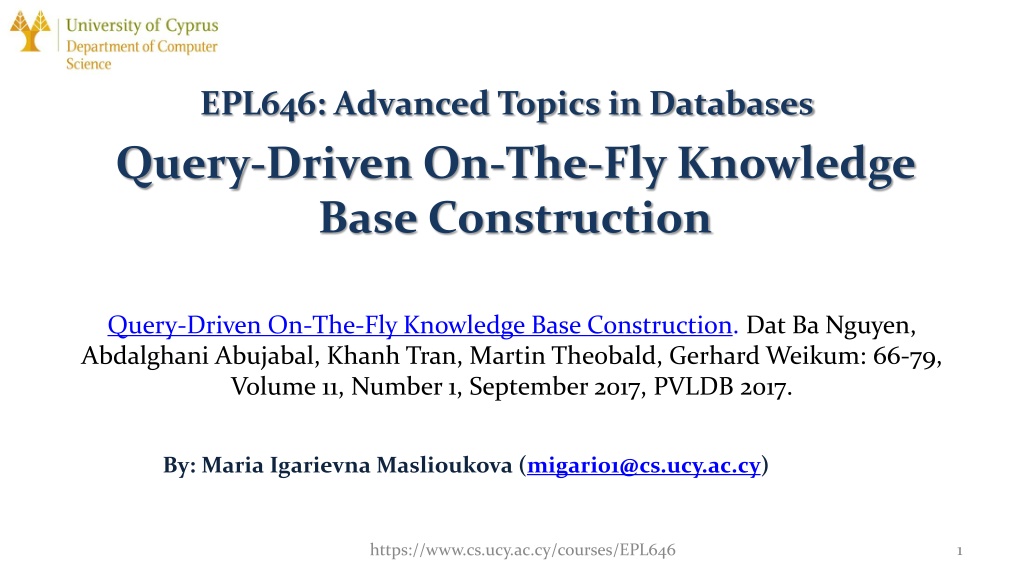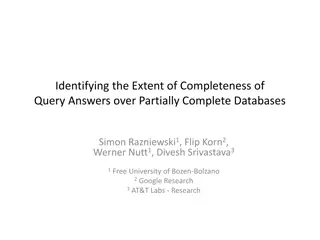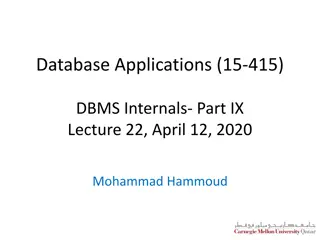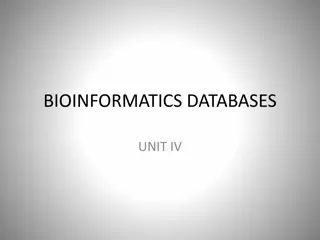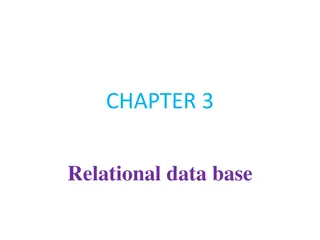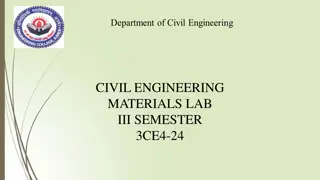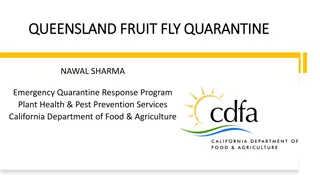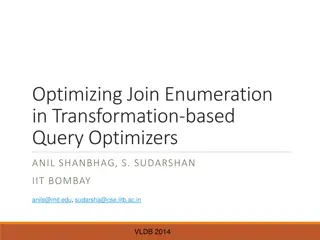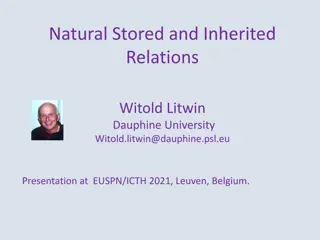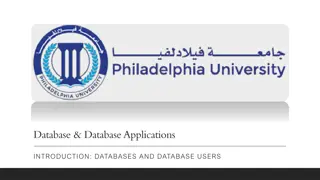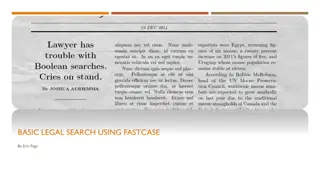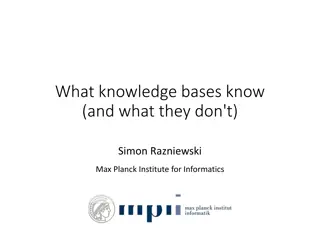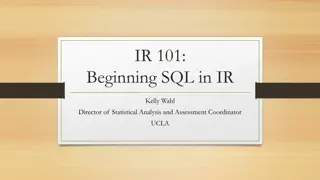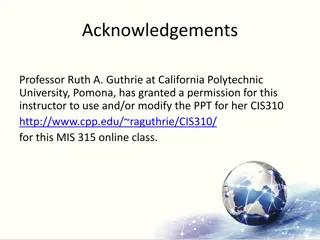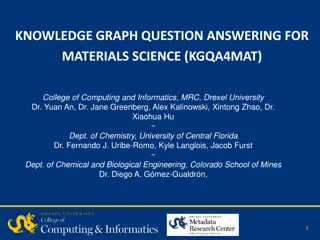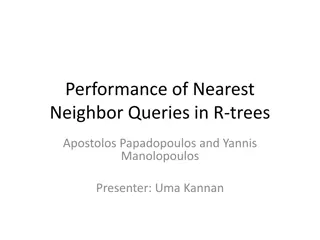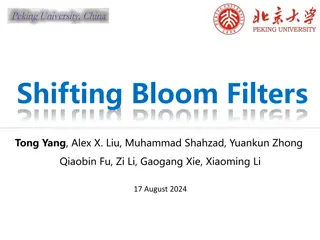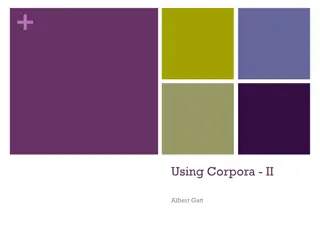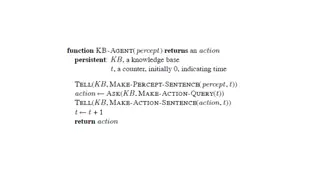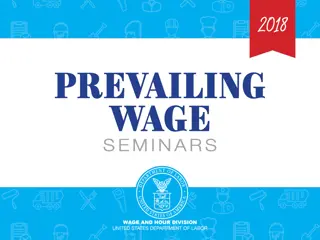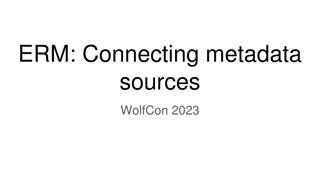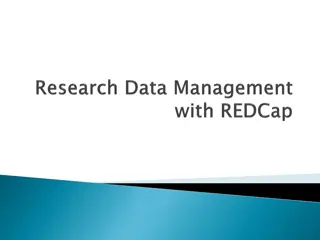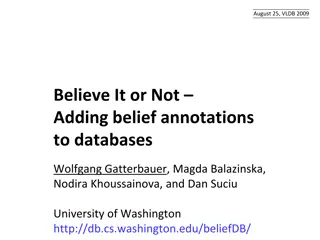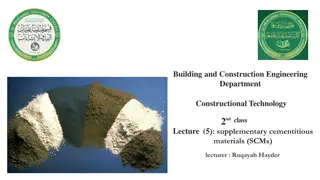Query-Driven On-The-Fly Knowledge Base Construction in Advanced Databases
This research delves into the cutting-edge topic of query-driven on-the-fly knowledge base construction, focusing on acquiring facts for a vast array of predicates and capturing billions of facts about entities in the world. Motivated by the limitations of existing knowledge bases, the study explores novel extraction specifications and a graph-based approach for organizing extractions. The presentation outlines the motivation behind the research, the design of the QKBfly system, semantic graph construction, graph densification, algorithmic processes, experimental results, and future directions. Key aspects include precision and recall in knowledge base development.
Download Presentation

Please find below an Image/Link to download the presentation.
The content on the website is provided AS IS for your information and personal use only. It may not be sold, licensed, or shared on other websites without obtaining consent from the author. Download presentation by click this link. If you encounter any issues during the download, it is possible that the publisher has removed the file from their server.
E N D
Presentation Transcript
EPL646: Advanced Topics in Databases Query-Driven On-The-Fly Knowledge Base Construction Query-Driven On-The-Fly Knowledge Base Construction. Dat Ba Nguyen, Abdalghani Abujabal, Khanh Tran, Martin Theobald, Gerhard Weikum: 66-79, Volume 11, Number 1, September 2017, PVLDB 2017. By: Maria Igarievna Maslioukova (migari01@cs.ucy.ac.cy) 1 https://www.cs.ucy.ac.cy/courses/EPL646
Presentation Outline Motivation QKBfly Design Semantic Graph Graph Densification Algorithm Canonicalization Experiments Conclusions and Future Work Student Research Presentations, Advanced Topics in Databases, Dept. of Computer Science University of Cyprus https://www.cs.ucy.ac.cy/courses/EPL646 2
Knowledge Base A knowledge base (KB) is a technology used to store complex structured and unstructured information used by a computer system. A knowledge-based system consists of a knowledge-base that represents facts about the world and an inference engine that can reason about those facts and use rules and other forms of logic to deduce new facts or highlight inconsistencies. -Wikipedia https://www.cs.ucy.ac.cy/courses/EPL646 3
Motivation State of the art KBs (Dbpedia [2], Yago [3], Wikidata [4], Freebase [5], OpenIE [8], DeepDive [6], DEFIE [7], etc.) QKBfly acquire facts for a much larger set of predicates capture billions of facts about world s entities limited in up-to-date coverage (what happens now in the world) capture ternary and higher-arity predicates query-driven (entity-centric query or a natural don t capture relationships among entities (ex. has_adopted_child, filed_divorce_from ) language question) question answering on emerging topics (on-the-fly don t apply synonym substitution ( Brad Pitt , Bradley Pitt , Oscar winner Pitt ) KB) novel for advance extractions specifications of predicates and rules are required (high overhead) graph-based approach for cleaning, canonicalizing and organizing noisy extractions https://www.cs.ucy.ac.cy/courses/EPL646 4
Presentation Outline Motivation QKBfly Design Semantic Graph Graph Densification Algorithm Canonicalization Experiments Conclusions and Future Work Student Research Presentations, Advanced Topics in Databases, Dept. of Computer Science University of Cyprus https://www.cs.ucy.ac.cy/courses/EPL646 5
KB Priorities Precision: fraction of correct tuples among the acquired ones Recall: fraction of correct tuples among the ones that could possibly be acquired from the input on-the-fly KB precision-oriented cleaning recall-oriented extraction https://www.cs.ucy.ac.cy/courses/EPL646 6
QKBfly Design Extraction: Linguistic pre-processing is used for handling the high diversity of input documents. (Specific tools for decomposing sentences into a set of clauses.) Cleaning: Remove false positives and semantic redundancy. The first by resolving entity mentions and co-references, and the second by canonicalizing relational predicates. (Transformed to a weighted MaxSat problem). https://www.cs.ucy.ac.cy/courses/EPL646 7
QKBfly Architecture 3) Canonicalization (merge co-references and paraphrase mapping ) 2) Graph- densification (entity disambiguation and co- reference resolution) 1) Build semantic graph from clauses in input documents https://www.cs.ucy.ac.cy/courses/EPL646 8
Static input Background Repositories: The background corpus (C) (Wikipedia full-text dump), the relational paraphrase repository (P) (PATTY [10]) and the entity repository (E) (Yago[3], with their gender attributes for better pronoun resolution). From (C), background statistics (S) are extracted. Statistics: Pre-processing linguistic tools, consisting of tokenization, part-of-speech (POS) tagging, noun-phrase chunking and named-entity recognition (NER), time tagging and ClausIE [9]. The Wikipedia-based corpus (C) clause components are mapped to Wikipedia entities by their href links. Finally (co-)occurrence statistics for clause-argument-types and the relationships among them are computed. https://www.cs.ucy.ac.cy/courses/EPL646 9
Presentation Outline Motivation QKBfly Design Semantic Graph Graph Densification Algorithm Canonicalization Experiments Conclusions and Future Work Student Research Presentations, Advanced Topics in Databases, Dept. of Computer Science University of Cyprus https://www.cs.ucy.ac.cy/courses/EPL646 10
Semantic Graph A semantic graph is created for every sentence in the input. A leaf node in this graph represents an occurrence of an entity, while an edge among two leaf nodes represents their relation. The per-sentence graphs are linked so that potentially the leaf nodes refer to the same entity. https://www.cs.ucy.ac.cy/courses/EPL646 11
Graph Components Edges Nodes 1. Depends edge links two dependent clauses. It links a clause node with the noun-phrase and pronoun nodes it contains. 2. Relation edge represents a relation that connects two noun-phrase or pronoun nodes (i.e., preposition such as to , in , etc.). Also, patterns of the form s noun (e.g., Pitt s ex-wife Angelina Jolie). 3. SameAs edge links two noun-phrase or pronoun nodes which refer to the same entity. For clauses with the same label (e.g., PERSON), string matching is used to determine their similarity (e.g., Brad Pitt and Pitt ). 4. Means edge links a noun-phrase or pronoun node with an entity node in the entity repository. https://www.cs.ucy.ac.cy/courses/EPL646 1. Clause node is generated for each detected clause. A clause may be connected to multiple dependent clauses in the same sentence. 2. Noun-phrase node is generated for each noun phrase detected by the noun-phrase chunker and for each named entity. 3. Pronoun node is generated for a pronoun (such as he , she , etc.). 4. Entity node is generated for each noun-phrase (e.g., Brad Pitt) that is matched in the entity repository. 12
Example https://www.cs.ucy.ac.cy/courses/EPL646 13
Presentation Outline Motivation QKBfly Design Semantic Graph Graph Densification Algorithm Canonicalization Experiments Conclusions and Future Work Student Research Presentations, Advanced Topics in Databases, Dept. of Computer Science University of Cyprus https://www.cs.ucy.ac.cy/courses/EPL646 14
Graph Densification Algorithm The semantic graph built according to the previous section will be mentioned as G =(N,R), where N is the set of nodes and R the set of edges (i.e., relationships ). Goal: Remove false-positive means and sameAs edges by solving a constraint-based optimization problem. Tool: A joint inference for the named-entity disambiguation (NED) and co-reference resolution (CR). https://www.cs.ucy.ac.cy/courses/EPL646 15
Edge Weights Given a subgraph S=<N N,R R> of G, the following dependencies among nodes exist: For each noun-phrase node ni, ent(ni,S) is the set of all entity nodes linked to ni by means edges in R . For each pronoun node pi, np(pi,S) is the set of all noun-phrase nodes linked to pi by sameAs edges in R . Further, ent(pi,S) denotes the union of all ent(nt,S) sets, where nt np(pi,S). https://www.cs.ucy.ac.cy/courses/EPL646 16
Weight of a Means Edge Weighted edge between a noun-phrase node ni and an entity node eij ent(ni,S) is computed as Where: a1 and a2 are hyperparameters prior(ni,eij) is the probability of a noun-phrase ni denoting an entity candidate eij. (the relative frequency under which a link points to a Wikipedia article that represents entity eij). sim(cxt(ni),cxt(eij)) is the similarity of two context vectors. The context vector of a noun-phrase, is built from tokens in the sentence it is contained and the context vector of an entity, is built from tokens occurring in the entity s Wikipedia article. Similarity measure is the weighted overlap coefficient between two vectors. https://www.cs.ucy.ac.cy/courses/EPL646 17
Weight of a Relation Edge Weighted edge between two noun-phrase or pronoun nodes ni, nt is computed as Where: a3 and a4 are hyperparameters coh(eij,etk): is the coherence between two entity candidates (the weighted overlap similarity between the entities context vectors). ts(eij,etk,ri,t): is the relative frequency under which the semantic types of eij,etk occur under the relation pattern ri,t in the clause set (all type combinations are summed, since an entity can have several types ). https://www.cs.ucy.ac.cy/courses/EPL646 18
Type Signatures 1. The Stanford NER tagger, SUTime, and ClausIE are run on all sentences in the corpus. 2. For all arguments and relations in the corpus, that are mapped to Wikipedia entities, a name or time expression (co-)occurrence statistics are computed. 3. Manually a sub-sumption hierarchy is built (e.g., FOOTBALLER ATHLETE PERSON, etc.). https://www.cs.ucy.ac.cy/courses/EPL646 19
Optimization Objective Find the densest subgraph S* = <N* N, R* R> that maximizes the sum of all edge weights in subgraph S following these constraints: 1.each noun-phrase node is connected to at most one entity node by a means edge in R* 2.each pronoun node is connected to at most one noun-phrase node by a sameAs edge in R* 3.all noun-phrase or pronoun nodes that are mutually linked by sameAs edges, are connected to the same entity 4.each pronoun node connected to a noun-phrase node that is connected to an entity node of type PERSON, for which the background KB provides gender information, gender must match. https://www.cs.ucy.ac.cy/courses/EPL646 20
Approximation Algorithm Constraint problem solving is NP-hard, thus a greedy algorithm is adopted as an approximation of the optimization objective by the following greedy algorithm. Algorithm: 1. Entity candidates must appear in the dictionary of the background KB or are unlinked noun-phrase nodes in the final subgraph (out-of-KB entities). 2. All noun-phrase nodes that are mutually connected via sameAs edges their entity candidate sets are intersected. 3. Iterate over graph s edges as long as none of the 4 constraints are violated (or no edges were removed) 1. Remove means or sameAs edge between two nodes with the smallest contribution to the objective function of the current subgraph S. 2. If removing an edge leaves an entity candidate isolated, then that entity node is removed. 3. Recompute the weights of all remaining edges (sameAs edges modifies the influence of relation edges). https://www.cs.ucy.ac.cy/courses/EPL646 21
Confidence Scores Additional filtering step, where a normalized confidence score is assigned to each noun-phrase or pronoun node ni that is disambiguated to an entity eij as where the denominator is the sum of all subgraphs St constructed from S* by replacing eij (and its associated means edge) with one of the original candidates eit (and its means edge). The confidence score is the minimum of the confidence scores of all disambiguated entities that occur in that fact. https://www.cs.ucy.ac.cy/courses/EPL646 22
Hyper-Parameter Tuning 1.162 sentences were manually annotated from 5 Wikipedia articles covering scientists, politicians, sports stars, business people and models. 2.Annotation resulted in 203 facts, each consisting of an emerging entity and a relation pattern (e.g.,<Larry Page, born in , Michigan>). 3.A graph G is constructed for each extracted fact, with a probability of choosing that fact as where the subgraph S will be constructed. 4.Finally, the hyperparameters are learned by maximizing the probability of the ground-truth annotations using L-BFGS optimization (a memory- efficient variant of stochastic gradient descent). https://www.cs.ucy.ac.cy/courses/EPL646 23
Presentation Outline Motivation QKBfly Design Semantic Graph Graph Densification Algorithm Canonicalization Experiments Conclusions and Future Work Student Research Presentations, Advanced Topics in Databases, Dept. of Computer Science University of Cyprus https://www.cs.ucy.ac.cy/courses/EPL646 24
Canonicalization 1.A node is either in the entity repository (or connected with a node in the repository via sameAs edge), either has low confidence scores belonging to the repository making it a new entity (up-to-date knowledge). 2.Nodes with the same label and edge labels that belong to the same synonym set (PATTY [10]) are combined into a single triple. (e.g play in , act in and star in ). 3.Ternary or higher-arity relations are constructed when ever noun-phrase or pronoun nodes are linked to the same clause node via depends edges, those nodes are merged into a single fact (capture more complex information). on-the-fly facts complete information https://www.cs.ucy.ac.cy/courses/EPL646 25
Examples up-to-date knowledge emerging entity long-tail entity ternary fact https://www.cs.ucy.ac.cy/courses/EPL646 26
Presentation Outline Motivation QKBfly Design Semantic Graph Graph Densification Algorithm Canonicalization Experiments Conclusions and Future Work Student Research Presentations, Advanced Topics in Databases, Dept. of Computer Science University of Cyprus https://www.cs.ucy.ac.cy/courses/EPL646 27
User Interface Input Source (Wikipedia or news articles) User Query No. of source documents Derived Facts Fact Filtering https://www.cs.ucy.ac.cy/courses/EPL646 28
Up-to-date facts Other KBs need manual setup to cover it https://www.cs.ucy.ac.cy/courses/EPL646 29
Experiments 1. On-the-fly KB vs DEFIE[7] 2. Greedy approximation algorithm vs integer linear programming algorithm 3. QKBfly s vs DeepDive[6] for spouses mentions 4. On-the-fly KB for ad-hoc question answering https://www.cs.ucy.ac.cy/courses/EPL646 30
On-the-fly KB vs DEFIE[7] DEFIE-Wikipedia dataset [7]: 14,072 randomly chosen Wikipedia pages with a total of 225,867 sentences. Reverb dataset [11]: 500 sentences (obtained by the random-link service of Yahoo). Compare different configurations of QKBfly against DEFIE: QKBfly joint fact extraction, NED and CR* QKBfly-pipeline performs 3 stage fact extraction, NED and CR (type signature is omitted) QKBfly-noun only performs fact extraction and NED (CR is omitted) DEFIE: a pipeline architecture with two stages for NED (Open IE and Babelfy [12]) *named entity disambiguation (NED) and co-reference resolution (CR) https://www.cs.ucy.ac.cy/courses/EPL646 31
Results on Fact Extraction* Conclusions: QKBfly-noun has the better performance QKBfly increases the number of extractions, having better precision and recall QKBfly is runtime efficient thus scalable for processing large inputs on the fly DEFIE is outperformed because it was optimized for short sentences (i.e. definitions) and fails to process complex text DEFIE offers only fact triplets while QKBfly offers higher-arity facts too (captures more complex relations) https://www.cs.ucy.ac.cy/courses/EPL646 32 *on DEFIE dataset
Results on Entity Disambiguation Babelfy [12]: a graph based approach for NED. Word sense disambiguation based on a loose identification of candidate meanings, coupled with a densest subgraph heuristic which selects high-coherence semantic interpretations (Since Babelfy does not consider pronouns, pronoun resolution is omitted). Conclusions: QKBfly gains 4% while QKBflypipeline loses 2% against Babelfy Errors of QKBfly-pipeline and Babelfy coming from the missing type signature feature (e.g., Liverpool the city vs Liverpool F.C. the soccer club). https://www.cs.ucy.ac.cy/courses/EPL646 33
Results on Initial Extraction* Conclusions: ClausIE best precision and number of extractions, but it is the slowest method because it doesn t provide output canonicalization. Another reason for ClausIE being slower is that the other methods benefit from using the MaltParser instead of the Stanford Parser. The purely pattern-based Reverb (doesn t use dependency parsing) is the fastest. *on Reverb dataset https://www.cs.ucy.ac.cy/courses/EPL646 34
Experiments 1. On-the-fly KB vs DEFIE[7] 2. Greedy approximation algorithm vs integer linear programming algorithm 3. QKBfly s vs DeepDive[6] for spouses mentions 4. On-the-fly KB for ad-hoc question answering https://www.cs.ucy.ac.cy/courses/EPL646 35
Greedy approximation algorithm vs integer linear programming algorithm Additionally to the DEFIE dataset, two new datasets are used for this experiment: News dataset: 100 sport news articles with 3,751 sentences extracted from more than 20 news websites (bbc.com, telegraph.co.uk, nytimes.com ,etc.). Wikia dataset: 10 Wikia pages with 880 sentences about Game of Thrones, with text descriptions about the series episodes. Compare QKBfly against QKBflu-ilp: QKBfly, performs NED and CR with the greedy approximation algorithm QKBfly-ilp, performs NED and CR with an Integer Linear Programming (ILP) approach (constraint problem with different types of weights and variables). https://www.cs.ucy.ac.cy/courses/EPL646 36
Results Conclusions: QKBfly-ilp gains 1%-2% in precision QKBfly-ilp is much slower than QKBfly (especially for long documents). This is because QKBfly-ilp handles a very large number of variables in the ILP translation of the graph problem (less suitable for on-the-fly KB construction). QKBfly loses around 10% in precision when working on the Wikia since 71% of its entities are new (e.g. movie characters), while only 24% of the entities from the News and 13% DEFIE dataset are emerging. https://www.cs.ucy.ac.cy/courses/EPL646 37
Experiments 1. On-the-fly KB vs DEFIE[7] 2. Greedy approximation algorithm vs integer linear programming algorithm 3. QKBfly s vs DeepDive[6] for spouses mentions 4. On-the-fly KB for ad-hoc question answering https://www.cs.ucy.ac.cy/courses/EPL646 38
QKBflys vs DeepDive[6] for spouses mentions DeepDive [6]: provides a pre-configured extraction model for the marriage relation. Retrained with instances of married couples in Dbpedia (KB)[2] as positive examples into the DeepDive learner. Compare QKBfly against DeepDive on a more traditional information extraction task on the DEFIE dataset (i.e. the instance extraction of the spouse relation). https://www.cs.ucy.ac.cy/courses/EPL646 39
Results Conclusions: Both systems perform well at lower recall levels (50 extractions) QKBfly outperforms DeepDive at higher recall levels. DeepDive is twice as fast as QKBfly, but QKBfly always performs extractions for all relations (and co-reference pronoun resolution) opposing to DeepDive which cares only for the spouse relation. A downside of DeepDive is the need for the manual setting of the model for each targeted relation. https://www.cs.ucy.ac.cy/courses/EPL646 40
Experiments 1. On-the-fly KB vs DEFIE[7] 2. Greedy approximation algorithm vs integer linear programming algorithm 3. QKBfly s vs DeepDive[6] for spouses mentions 4. On-the-fly KB for ad-hoc question answering https://www.cs.ucy.ac.cy/courses/EPL646 41
On-the-fly KB for ad-hoc question answering Test QKBfly on a newly designed QA benchmark ( GoogleTrendsQuestions ). Using Google Trends service 50 recent events of wider interest were identified. Students were asked to formulate meaningful questions on these events and provide the gold-standard answers. Compare different configurations of QKBfly against Freebase[5]: QKBfly-triples: the on-the-fly KB is limited to subject-predicate-object (SPO) triples. Sentence-Answers: text-centric baseline. QKBfly is used to retrieve relevant sentences, but does not perform any fact extraction (no fact repository is available upfront). Entities in these sentences then become answer candidates. A type filter is applied on candidate answers to ensure the have the expected type(s) (e.g. questions starting with Who have answers of types PERSON, CHARACTER or ORGANIZATION). Each answer candidate is feeded to a pretrained binary classifier (SVM). The positively labeled candidates are the final answers. QA-Freebase baseline: is a static KB where the same QA method is applied on the fact collection of Freebase. https://www.cs.ucy.ac.cy/courses/EPL646 42
Results on the GoogleTrendsQuestions benchmark Conclusions: QKBfly achieves the best precision, recall and F1 score QA-Freebase and Sentence-Answers perform far inferior. Particularly, QA- Freebase returns empty results in most cases due to the lack of facts about recent events (static KB). https://www.cs.ucy.ac.cy/courses/EPL646 43
Example of event questions and returned facts QKBfly performs better than QKBfly-triples in questions which require ternary facts, such as Who plays Han Solo in Star Wars: The Force Awakens ? . https://www.cs.ucy.ac.cy/courses/EPL646 44
Presentation Outline Motivation QKBfly Design Semantic Graph Graph Densification Algorithm Canonicalization Experiments Conclusions and Future Work Student Research Presentations, Advanced Topics in Databases, Dept. of Computer Science University of Cyprus https://www.cs.ucy.ac.cy/courses/EPL646 45
Conclusions and Future Work QKBfly: builds on-the-fly knowledge bases in a query-driven manner. A much larger set of predicates is acquired than those in mainstream KBs. Facts are canonicalized. Use cases for QKBfly: ad-hoc question answering, summarization and other kinds of machine-reading applications. Improve the extraction speed and quality of the on-the-fly KB output. Apply on-the-fly relational paraphrase mining. https://www.cs.ucy.ac.cy/courses/EPL646 46
References (1) All figures were taken by the paper presented [1] [1] Query-Driven On-The-Fly Knowledge Base Construction. Dat Ba Nguyen, Abdalghani Abujabal, Khanh Tran, Martin Theobald, Gerhard Weikum: 66-79, Volume 11, Number 1, September 2017, PVLDB 2017. [2] DBpedia: A Nucleus for a Web of Open Data. S. Auer, C. Bizer, G. Kobilarov, J. Lehmann, and Z. Ives. In ISWC, pages 11 15, 2007. [3] Yago: A Core of Semantic Knowledge. F. M. Suchanek, G. Kasneci, and G. Weikum. In WWW, pages 697 706, 2007. [4] Wikidata: A Free Collaborative Knowledgebase. D. Vrand c c and M. Kr tzsch. CACM, 57(10):78 85, 2014. [5] Freebase: A Collaboratively Created Graph Database for Structuring Human Knowledge. K. Bollacker, C. Evans, P. Paritosh, T. Sturge, and J. Taylor. In SIGMOD, pages 1247 1250, 2008. https://www.cs.ucy.ac.cy/courses/EPL646 47
References (2) [6] DeepDive: Web-scale Knowledge-base Construction using Statistical Learning and Inference. F. Niu, C. Zhang, C. Re, and J. W. Shavlik. In VLDS, pages 25 28, 2012. [7] Large-Scale Information Extraction from Textual Definitions through Deep Syntactic and Semantic Analysis. C. D. Bovi, L. Telesca, and R. Navigli. TACL, 3:529 543, 2015 [8] Open Information Extraction from the Web. M. Banko, M. J. Cafarella, S. Soderland, M. Broadhead, and O. Etzioni. In IJCAI, pages 2670 2676, 2007. [9] ClausIE: Clause-based Open Information Extraction. L. Del Corro and R. Gemulla. In WWW, pages 355 366, 2013. [10] PATTY: A Taxonomy of Relational Patterns with Semantic Types. N. Nakashole, G. Weikum, and F. Suchanek. In EMNLP-CoNLL, pages 1135 1145, 2012. [11] Identifying Relations for Open Information Extraction. A. Fader, S. Soderland, and O. Etzioni. In EMNLP, pages 1535 1545, 2011. https://www.cs.ucy.ac.cy/courses/EPL646 48
References (3) [12] Entity Linking meets Word Sense Disambiguation: a Unified Approach. A. Moro, A. Raganato, and R. Navigli. TACL, 2:231 244, 2014. https://www.cs.ucy.ac.cy/courses/EPL646 49
